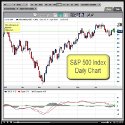Technical Analysis Basics: Gaps and Other Chart Patterns
January 15, 2010 | No Comments | Course
This article is part of the Trend Technician Technical Analysis Basics series. Be sure to read the rest of the series.
The final component of a classical charting education is the study patterns. Chartists can name a bewildering array of patterns and it would be ridiculous to try to cover them all. Moreover it’s not clear that they provide as much value as their proponents might argue. That being said, there are several basic patterns that are routinely discussed and are worth noting. If nothing else the fact that people believe in these patterns means they will likely have some merit.
Gaps
Gaps occur when the low of a day is higher than the high of the previous day, or the high of a given day is lower than the low of the previous day. They are quite easy to see on charts and they tend to stand out. Gaps often occur on the heels of news or other outside influences, however they can be mysterious.
Typically gaps indicate a burst of momentum in a given direction. However they can also indicate an aberration that will be corrected. The conventional wisdom in telling the difference is that gaps that are followed by new extremes in the same direction are indicators in that direction, while those that do not make new extremes will usually “close the gap.” So if a stock gaps up and subsequently makes new relative highs, then the gap is considered to be “confirmed.” If on the other hand the stock fails to make new relative highs, it’s likely that the stock price will return to pre-gap levels.
Other Patterns
There are a myriad of other patterns. We may cover them in more detail in individual articles, but they are of less use than basic support, resistance and trend analysis in the author’s opinion. Some of the more common ones like the head and shoulders or double top/bottom can be useful tools, but others can be nearly a Rorschach test, where the investor can see what he or she wants to see. Here is a brief list of some of the more common patterns:
- Head and Shoulders
- Lines
- Flags
- Triangles
- Rectangles
Each of these may have some merit, but I recommend using more clear cut indicators in addition to these in your analysis.


